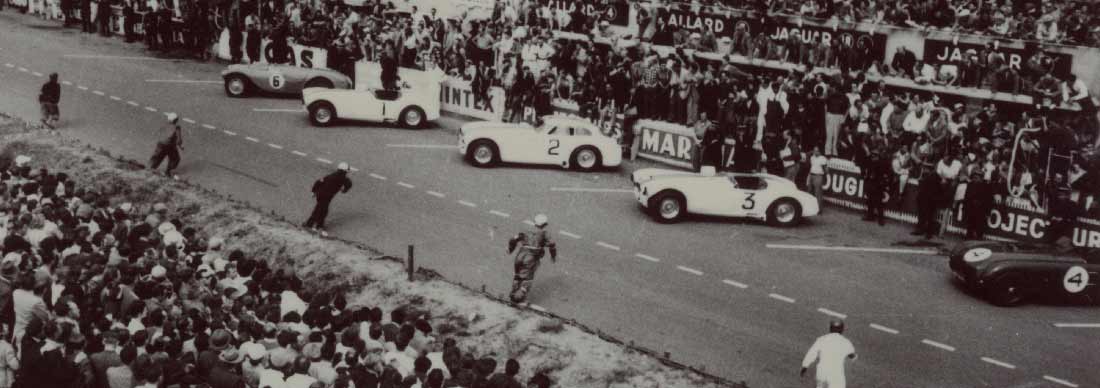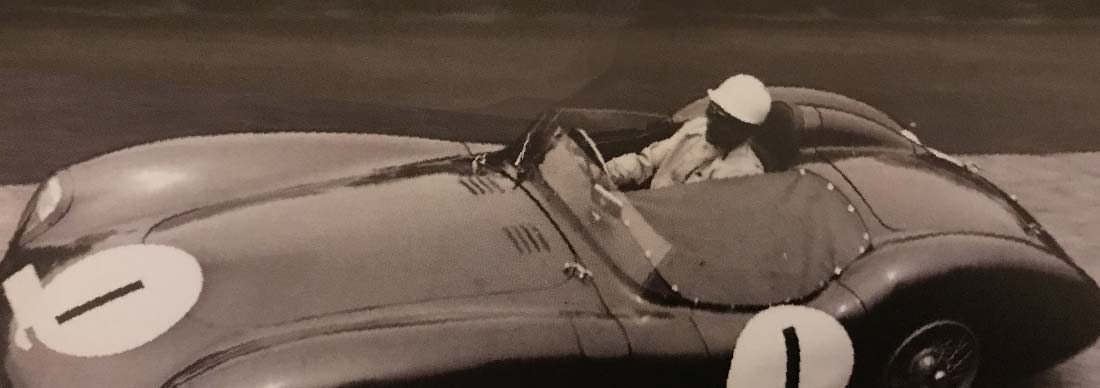
Bob Blake of Cunningham, by Philip Porter
Bob Blake was a remarkable and delightful man. A life member of the SCCA, in 1936 he started building race cars in Arlington, Virginia for Ted Horn and others. Stationed in England during the war with the US Third Army, he married a local girl. When the infamous Cadillac-based Cunningham ‘Le Monstre’ was damaged in practice for the 1950 Le Mans 24-hour race, entrant and driver Briggs Cunningham asked Bob to dash over to France to repair it.
This led to a job offer from Briggs and Bob was to build all the Cunningham race and road cars between 1951 and 1955. When Briggs had to give up building his own cars, Bob moved back to England and joined Jaguar, working in the Comp Shop and Experimental Dept., and later Styling. He was a highly-valued member of engineering supremo Bill Heynes’s special projects team that included Malcolm Sayer and Mike Kimberley.
This is what the great Briggs Cunningham had to say about Bob when his employment came to an end.

Towards the end of his career, Bob built a number of clay models in the Jaguar Styling Dept., just as he had done for Cunningham. This looks like a clay for what would become the C-1 road car.


Apart from the racers, Bob built the road cars that in production would be bodied in Italy by Vignale. This looks like the prototype C-1 being built. Not surprisingly, Bob was always referred to as ‘an artist in metal’.


The C-1 road car was completed first and then the C-1R racers were based on this design.

The quiet American quickly won the respect of all at Jaguar. He was very much involved in the building of the E-type prototypes, working closely with Malcolm Sayer. Bob told me that he actually inspired the idea for the Fixed Head Coupe ‘E’. One day, he took a bunch of welding rods to one of the roadster prototypes and created a wire frame outline of a roof. Sir William came into the Experimental Dept., as was his wont, spotted this, asked who had done it, spent ages studying it and then said, according to Blake, ‘It’s good. We’ll make it’.
Supporting this account is the fact that Bob had created two Cunningham coupés in the early ‘50s, one for the road and one for the track (seen here at the start of the 1952 Le Mans race). Furthermore it has always been a pet theory of mine - and nothing more than a theory - that the reason the E-type tailgate is hinged on the side and not at the top, is that a number of ‘50s American station wagons had, I believe, a tailgate that opens horizontally.

Also notable in Bob’s career was his leading role in creating the Jaguar XK-SS, drawing all the components needed to modify the D-types in his modest exercise book. The slender bumpers he handmade would be seen later on the E-type, and he has also had a hand in creating the XJ13. He was one of the friendliest and most charming men I ever interviewed.
These illustrations are copies of the originals he lent me. When Bob sadly died in 2003, I am told his widow chucked everything in the bin. Bob was one of the backroom heroes.
Books by Philip Porter
Other articles by Philip Porter





4 comments
Tim Crowder have you got any pictures of the two-man race car as I think I have the same body as two bodies were built
Dayne Bartlett
I too have a “R.F.Blake, Arlington” build tag on my single seat Ford Riley powered race car and am in the same predicament as Mr. Crowder above desperately looking for racing information to positively identify my car. It may or may not be a Horn/ Hinnershitz car but there are not many Riley powered Blake body car’s . We have clues such as the Blake body tag, the 1936 (or later) Ford V8 wire wheels, the iron OHV Riley heads are pre War. There are no race numbers or logo’s on the car or any other identifying characteristic’s such as serial numbers. My theory is that Mr. Blakes beautiful designed bodies from the late 30’s and the success of Horn & Hinnershitz caught the attention of Briggs Cunningham. Can anyone please fill in the gaps as to how Horn & Blake met or knew one another ? I know Horn had his race shop in Paterson, NJ and yes, I have the book of his life by Clymer but there isn’t any further insight as to his relationship with Bob Blake. Horn ran 5 cars late in his career after gaining success at Indy which allowed him to fund the team Ted Horn Enterprise ( T.H.E.) , Many thanks !
Rochester, NY
Andrew Herrala
Hi , please help , have you any pictures of bob Blake’s early work , 1930s
He built 2 aluminium body’s for mr dick Gilbert , racing cars , Alvis
I have one of the body’s believing the other has been destroyed , this could be a one off.
He raced number 51 , reg ep 5572
It has been clarified he built them and the body I have is the race car,
Any information gratefully received
Thanks dayne
DAyne bArtlett
I have a late 1930’s all aluminum, two man race car body that was fabricated by Bob Blake when his shop was in Arlington Virginia. I’m looking for any photographs or documents related to his early racers. Currently, I’m researching the racing and driver history for my car but not having much luck yet. This is a great article about Bob Blake.
Thank you in advance for your help.
Tim Crowder
(Ashland, Virginia)
Tim Crowder
Leave a comment
This site is protected by hCaptcha and the hCaptcha Privacy Policy and Terms of Service apply.